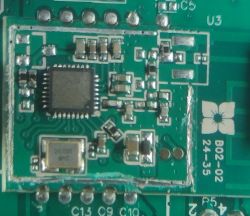Welcome!
I want to read the temperature from the BME280 in a lua script. In datasheets I read that the temperature is stored at 0xFA , 0xFB and 0xFC .
![[lua] BME280 - How to correctly read the temperature from registers 0xFA-0xFC? [lua] BME280 - How to correctly read the temperature from registers 0xFA-0xFC?](https://obrazki.elektroda.pl/6021873300_1518618329_thumb.jpg) .
.
After reading these addresses with the command
.
I received 128 , 0 and 0 respectively.
.
I know that the read value 128 is not the temperature. I therefore have a question. How is the temperature read out?
I want to read the temperature from the BME280 in a lua script. In datasheets I read that the temperature is stored at 0xFA , 0xFB and 0xFC .
![[lua] BME280 - How to correctly read the temperature from registers 0xFA-0xFC? [lua] BME280 - How to correctly read the temperature from registers 0xFA-0xFC?](https://obrazki.elektroda.pl/6021873300_1518618329_thumb.jpg) .
.
After reading these addresses with the command
Code: Lua
I received 128 , 0 and 0 respectively.
Code: Lua
I know that the read value 128 is not the temperature. I therefore have a question. How is the temperature read out?






![[lua] BME280 - How to correctly read the temperature from registers 0xFA-0xFC? [lua] BME280 - How to correctly read the temperature from registers 0xFA-0xFC?](https://obrazki.elektroda.pl/1334011000_1518794585_thumb.jpg)
![[lua] BME280 - How to correctly read the temperature from registers 0xFA-0xFC? [lua] BME280 - How to correctly read the temperature from registers 0xFA-0xFC?](https://obrazki.elektroda.pl/5275929800_1519156043_thumb.jpg)
![[lua] BME280 - How to correctly read the temperature from registers 0xFA-0xFC? [lua] BME280 - How to correctly read the temperature from registers 0xFA-0xFC?](https://obrazki.elektroda.pl/9542117800_1519197231_thumb.jpg)
![[lua] BME280 - How to correctly read the temperature from registers 0xFA-0xFC? [lua] BME280 - How to correctly read the temperature from registers 0xFA-0xFC?](https://obrazki.elektroda.pl/3119830900_1519240238_thumb.jpg)
![[lua] BME280 - How to correctly read the temperature from registers 0xFA-0xFC? [lua] BME280 - How to correctly read the temperature from registers 0xFA-0xFC?](https://obrazki.elektroda.pl/8622941300_1519240937_thumb.jpg)
![[lua] BME280 - How to correctly read the temperature from registers 0xFA-0xFC? [lua] BME280 - How to correctly read the temperature from registers 0xFA-0xFC?](https://obrazki.elektroda.pl/9522387600_1519393411_thumb.jpg)